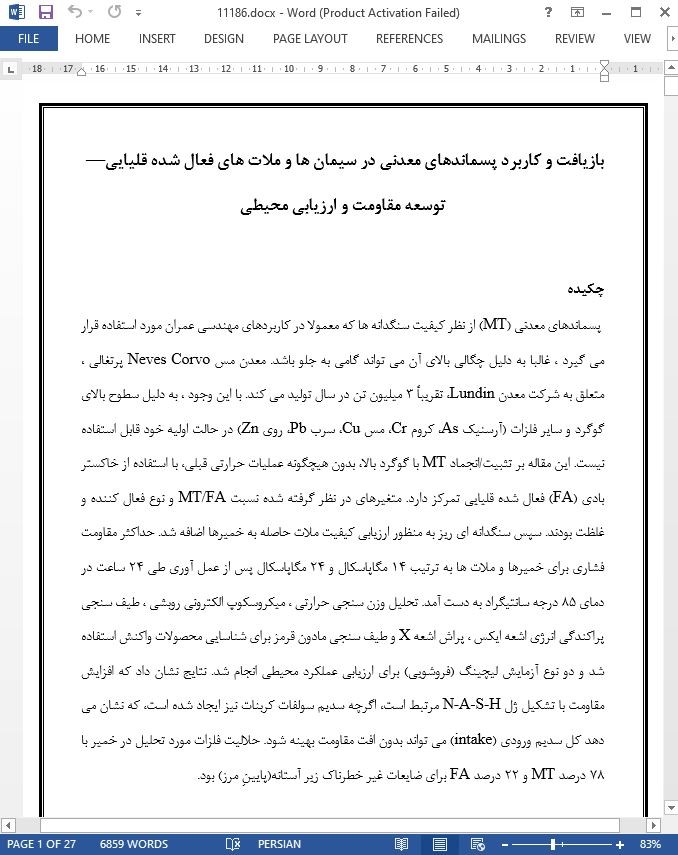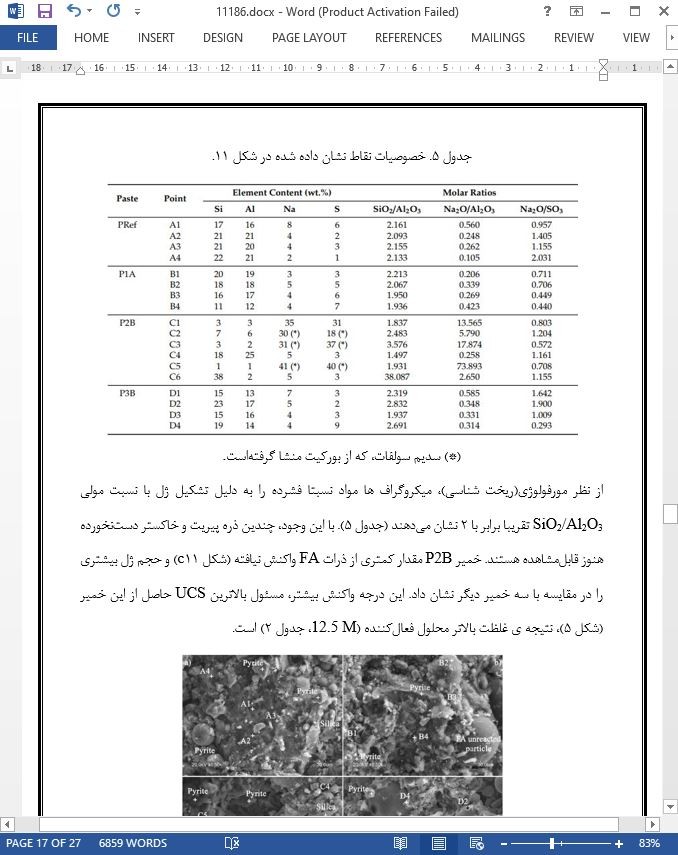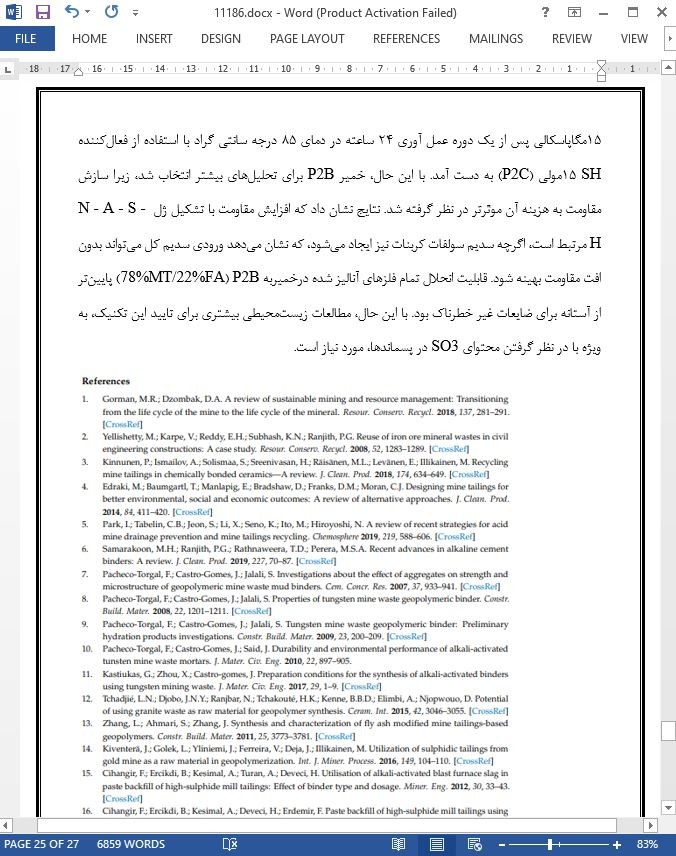
بازیافت و کاربرد پسماندهای معدنی در سیمان ها و ملات های فعال شده قلیایی
چکیده
پسماندهای معدنی (MT) از نظر کیفیت سنگدانه ها که معمولا در کاربردهای مهندسی عمران مورد استفاده قرار می گیرد ، غالبا به دلیل چگالی بالای آن می تواند گامی به جلو باشد. معدن مس Neves Corvo پرتغالی ، متعلق به شرکت معدن Lundin، تقریباً 3 میلیون تن در سال تولید می کند. با این وجود ، به دلیل سطوح بالای گوگرد و سایر فلزات (آرسنیک As، کروم Cr، مس Cu، سرب Pb، روی Zn) در حالت اولیه خود قابل استفاده نیست. این مقاله بر تثبیت/انجماد MT با گوگرد بالا، بدون هیچگونه عملیات حرارتی قبلی، با استفاده از خاکستر بادی (FA) فعال شده قلیایی تمرکز دارد. متغیرهای در نظر گرفته شده نسبت MT/FA و نوع فعال کننده و غلظت بودند. سپس سنگدانه ای ریز به منظور ارزیابی کیفیت ملات حاصله به خمیرها اضافه شد. حداکثر مقاومت فشاری برای خمیرها و ملات ها به ترتیب 14 مگاپاسکال و 24 مگاپاسکال پس از عمل آوری طی 24 ساعت در دمای 85 درجه سانتیگراد به دست آمد. تحلیل وزن سنجی حرارتی ، میکروسکوپ الکترونی روبشی ، طیف سنجی پراکندگی انرژی اشعه ایکس ، پراش اشعه X و طیف سنجی مادون قرمز برای شناسایی محصولات واکنش استفاده شد و دو نوع آزمایش لیچینگ (فروشویی) برای ارزیابی عملکرد محیطی انجام شد. نتایج نشان داد که افزایش مقاومت با تشکیل ژل N-A-S-H مرتبط است، اگرچه سدیم سولفات کربنات نیز ایجاد شده است، که نشان می دهد کل سدیم ورودی (intake) می تواند بدون افت مقاومت بهینه شود. حلالیت فلزات مورد تحلیل در خمیر با 78 درصد MT و 22 درصد FA برای ضایعات غیر خطرناک زیر آستانه(پایینِ مرز) بود.
1. مقدمه
این چارچوب بهینهسازی پایداری بخش معدن را مورد توجه قرار میدهد که در حال حاضر در حال وقوع یک انقلاب بسیار مهم است. این صنعت در حال رها کردن تمرکز بر کارآیی عملیات با هدف کاهش ضایعات دور انداخته شده و تغییر به یک الگوی جهانی است که نه تنها عملیات استخراج معدن بلکه چرخه عمر کامل این صنعت حیاتی را نیز در بر میگیرد [۱]. ضایعات حاصل از عملیات استخراج معدن میتواند ناشی از خرد شدن یا دیگر روشهای پردازش پیچیدهتر باشد. مورد اول، که به طور معمول "ضایعات معدنی" ساده نامیده میشود، در صنعت ساختوساز (به عنوان مثال، بتن، خاکریزها) استفاده میشود چون هیچ گونه نگرانی زیستمحیطی خاصی را ایجاد نمیکند؛ مورد دوم، که معمولا به آن "پسماندهای معدنی" (MT) گفته میشود، به دلیل میزان بالای انواع مختلف آلایندهها که در تماس با آب میتوان آنها را شست، مواد نگرانکنندهتر تولید میکند [2-4].
۵. نتیجهگیری ها
از نظر رفتار مکانیکی، تثبیت پسماندهای معدنی از استخراج مس با استفاده از FA فعال شده قلیایی یک روش موثر است که میتواند برای کاربردهای کم مقاومت (<20 MPa)، مانند خاکریزها یا اساس راه در نظر گرفته شود.این روش دارای مزیت اجتناب ازعملیات حرارتی برای افزایش سطح آمورفیزاسیون است در حالی که تنها به ۲۵ تا ۳۰ درصد FA نیاز دارد یعنی ۷۰ تا ۷۵ درصد خمیر، ضایعات خواهد بود. این نکته مهم است چون نشاندهنده جایگزینی برای دفن زباله سنتی است، و همچنین مصرف سیمان را کاهش میدهد. با توجه به اینکه کاربردهای ذکر شده در بالا به حجم بالایی از مواد نیاز دارند، این محلول جایگزین مناسبی برای چسبانندههای(مواد سیمانی) معمولی از نظر خواص مکانیکی، سازگار بودن محیطی، و مقرونبهصرفه بودن است. یک UCS ۱۵مگاپاسکالی پس از یک دوره عمل آوری ۲۴ ساعته در دمای ۸۵ درجه سانتی گراد با استفاده از فعالکننده SH ۱۵مولی (P2C) به دست آمد.
Abstract
Mine tailings (MT) could represent a step forward in terms of the quality of the aggregates usually used in civil engineering applications, mostly due to its high density. The Portuguese Neves Corvo copper mine, owned by the Lundin Mining Corporation, produces approximately 3 million tonnes per year. Nevertheless, it cannot be used in its original state, due to its high levels of sulphur and other metals (As, Cr, Cu, Pb, Zn). This paper focuses on the stabilisation/solidification of high-sulphur MT, without any previous thermal treatment, using alkali-activated fly ash (FA). The variables considered were the MT/FA ratio and the activator type and concentration. A fine aggregate was then added to the pastes to assess the quality of the resulting mortar. Maximum compressive strengths of 14 MPa and 24 MPa were obtained for the pastes and mortars, respectively, after curing for 24 h at 85 °C. Thermogravimetric analysis, scanning electron microscopy, X-ray energy dispersive spectroscopy, X-ray diffraction, and infrared spectroscopy were used to characterize the reaction products, and two types of leaching tests were performed to assess the environmental performance. The results showed that the strength increase is related with the formation of a N-A-S-H gel, although sodium sulphate carbonate was also developed, suggesting that the total sodium intake could be optimized without strength loss. The solubility of the analysed metals in the paste with 78% MT and 22% FA was below the threshold for non-hazardous waste.
1. Introduction
The framework addressing the sustainability optimisation of the mining sector is currently undergoing a very significant revolution. It is abandoning the focus on the efficiency of operations, aiming to reduce the disposed waste, and shifting to a more global paradigm, encompassing not only the mining operations but also the complete life cycle of this vital industry [1]. Wastes resulting from mining operations can result either from crushing or other, more complex processing methods. The former, normally referred to as plain “mining waste”, has been used in the construction industry (e.g., concrete, embankments) as it does not raise any special environmental concerns; the latter, usually referred to as “mine tailings” (MT), produces more worrying materials due to its high levels of different kinds of contaminants which can be washed away when in contact with water [2,3,4].
5. Conclusions
In terms of mechanical behaviour, the stabilisation of mine tailings from copper extraction using alkali-activated FA is an effective procedure which can be considered for low-strength applications (<20 MPa), like embankments or road bases. This procedure has the advantage of avoiding thermic treatment to increase the amorphisation level, while requiring only 25%–30% FA, i.e., 70%–75% of the paste will be tailings. This is significant since it represents an alternative to traditional landfilling, and it also reduces cement consumption. Considering that the above-mentioned applications require high volumes of material, this solution represents a suitable alternative to conventional binders in terms of mechanical properties, environmental friendliness, and cost-effectiveness. A UCS of 15 MPa was obtained after a curing period of 24 h at 85 °C using a 15 molal SH activator (P2C). However, the P2B paste was chosen for further analyses, since its strength/cost compromise was considered to be more effective.
چکیده
1. مقدمه
۲. مواد و روشها
2.1. مصالح
۲.۲. آمادهسازی، توصیف تحلیلی، و آزمایش مکانیکی
۲.۳. آزمایش های لیچینگ(فروشویی)
۳. نتایج
3.1. UCS
3.2. تحلیل وزن سنجی حرارتی
۳. ۳. توصیف ویژگی های کانی شناختی و ریزساختاری
3.4. عملکرد زیست محیطی
۴. بحث
۵. نتیجه گیری ها
Abstract
1. Introduction
2. Materials and Methods
2.1. Materials
2.2. Preparation, Analytical Characterisation, and Mechanical Testing
2.3. Leaching Tests
3. Results
3.1. UCS
3.2. Thermogravimetric Analysis
3.3. Mineralogical and Microstructural Characterization
3.4. Environmental Performance
4. Discussion
- ترجمه فارسی مقاله با فرمت ورد (word) با قابلیت ویرایش، بدون آرم سایت ای ترجمه
- ترجمه فارسی مقاله با فرمت pdf، بدون آرم سایت ای ترجمه



